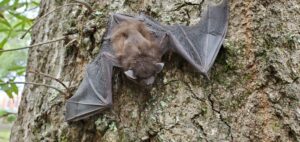It’s Bat Time!

There are several known bat species in Georgia, and they have a habit of moving into attics, hollow walls, and any other dark place they can find during the summer to have their young. From April to July, bat pups are born and are too young to fly. During these months, it is important to NOT trap them inside your attic since the babies will die. Once the babies can fly, it is time to remove any unwanted visitors from your home before winter hibernation begins. There is a window of time that a trained and licensed Nuisance Wildlife Control Operator can come in and diagnose the situation.
Why should a homeowner be concerned about bats in the attic? Most people know that bats have been known as disease carriers. The guano they leave behind is also extremely unpleasant to smell, especially in your home. Bats can bring bat bugs and other parasites known as ectoparasites into your attic. Ectoparasites can live outside their host, so the bat can leave and the parasite stays. Bats, like most wild animals, will likely bite you if you try to move them. For this reason, a professional is the best option in this situation. Both for the homeowner’s safety and the bats’ safety, a trained and licensed wildlife professional has experience and knowledge and can more efficiently solve the problem of bats in the attic.
Now that fall is here, it is important to move quickly to get bats out of the home before they begin to hibernate in the winter. The best way to do that is to deny access to the bats. Amazingly, some smaller-sized bats can enter the home through a pencil size crack! And most bats can come in through a quarter-sized hole. That can be hard to find for a homeowner, so a thorough check is a must.
A sure sign of bats is the presence of droppings. It can be confusing as to whether the droppings are from mice or from bats since they are similar, but the bat guano is shiny and has pointed ends…oh and it sticks to stuff. Gross, right? That may be more information than you wanted, but now you are empowered to go search your attic for bat signs. Impress your friends. But remember the caution about disease. Being in an enclosed area and touching the guano can be unhealthy.
Anyway, another sign that you have bats is that the openings to the outside of your home are dirty. The bats squeeze through and often get the surface of the hole dirty and leave poop right at the opening. If you have seen a peculiar droppings at one end or the other of your home under the gable vent, that is a common sign of bats. You usually see it on the driveway in these cases.
There are many ideas as to how to get rid of bats. Lights and a blast of air from fans have long been touted as a quick fix to bat removal. But there is no research evidence to support the claim. Naphthalene, a common ingredient in mothballs, has been successfully used to repel bats, squirrels, and other wildlife. Do know this…mothballs have a smell of their own that can be quite intolerant in great quantities. If you do choose to try this method, use them with this in mind. Maybe throwing pounds of mothballs in your attic is not the way to go. You might end up going from one problem to yet another! Use the product as directed on the label.
A typical removal method is using a one-way door. Once the points of entry are found, a wildlife professional places these in the correct locations. The “door” allows the bats to get out but not back in. You can see why this is not done while the babies need their moms but only after the babies can leave the nest on their own in the fall. The moms come back several times during the night to feed their young during the summer season but by fall the pups are independent and able to get out safely. It is important to understand the habits of bats and to protect them. Bats are extremely beneficial and valuable to our environment, so care should be taken to protect them.
Once the bats are out of the attic, the holes need to be sealed. Stainless steel can be placed in the cracks and then caulk applied over top. If the holes are closed soon after dark, the bats are out for dinner and unlikely to be a problem.
Bats can be a huge aggravation, but it is best to deal with the problem as soon as possible. As you can see, there are many steps to the process. First, knowledge of the bat season and when removal can take place is a must. Second, the source of entry for the bats should be found. Next, the safe removal of the bats is carefully performed. Finally, the exclusion work to keep the bats out of the home takes place.
It is not quick. It is not easy. It does require patience and time. If you are having bat problems, give us a call at Canton Termite and Pest Control at 770-479-1598. We are here for
By:Robin
